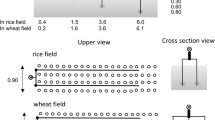Summary
Lucerne was irrigated for three years on a slowly permeable, duplex soil, with saline water up to 2.4 dS m−1 without significant yield decline. Irrigation water of 4.5 dS m−1 significantly reduced yield. Lucerne yield was most closely related to the soil ECe of the 0–15 cm depth, rather than the total rootzone, and was described by; Relative yield=100−6.5 (ECe-2.1). While lucerne roots reached depths of at least 150 cm, approximately 80% of total root length was located in the 0–60 cm depth.
Increasing salinity increased the plant concentrations of sodium and chloride, however, these changes were not closely related to changes in yield.
Soil salinity increased with increasing salinity of the applied water. However, during the irrigation season water penetration and the accumulation of salt within the profile was predominantly restricted to the 0–60 cm depth. No portion of the applied irrigation water was available as a leaching fraction. Any leaching of salts to the watertable, particularly below 120 cm, was due to winter rainfall rather than the application of summer irrigation water.
Ripping the soil to a depth of 75 cm increased water infiltration and resulted in increased crop yields, but did not significantly affect the crop relative yield-soil ECe relationship.
From the results it is proposed that on the slowly permeable duplex soils, when watertable depth is controlled, management strategies for lucerne irrigated with saline water should be based on controlling the salinity of the shallow soil depths, to 60 cm.
Similar content being viewed by others
References
Andrew CS, Robins MF (1969) The effects of potassium on the growth and chemical composition of some tropical and temperate pasture legumes. I. Growth and critical percentages of potassium. Aust J Agric Res 20:999
Bernstein L, Francois LE (1973) Leaching requirement studies: sensitivity of alfalfa to salinity of irrigation and drainage waters. Proc Soil Sci Soc Am 37:931
Bernstein L, Pearson GA (1956) Influence of exchangeable sodium on the yield and chemical composition of plants: I. Green beans, garden beets, clover and alfalfa. Proc Soil Sci Soc Am 82:247
Best RJ (1929) A rapid electrometric method for determining the chloride content of soils. J Agric Sci 19:533
Bower JG, Ogata G, Tucker JM (1969) Root zone salt profiles and alfalfa growth as influenced by irrigation water salinity and leaching fraction. Agron 161:783
Chang CW (1961) Effects of saline irrigation water and exchangeable sodium on soil properties and on growth and cation content of alfalfa and cotton. Soil Sci 91:29
Cockroft B, Tisdall JM (1978) Soil management, soil structure and root activity. In: Emerson WW, Bond RD, Dexter AR (eds) Modification of soil structure. Wiley, Chichester, pp 387–391
Greenway H, Munns R (1980) Mechanisms of salt tolerance in non-halophytes. Annu Rev Plant Physiol 31:149
Hoffman GJ (1981) Alleviating salinity stress. In: Arkin GF, Taylor HM (eds) Modifying the root environment to reduce crop stress. ASAE St. Joseph, Michigan, pp 305–343
Ingvalson RD, Rhoades JD, Page AL (1976) Correlation of alfalfa yield with various index of salinity. Soil Sci 122:145
Lyle CW (1984) Groundwater utilisation in the Shepparton Region. Search 14:326
Maas EV, Hoffman GJ (1977) Crop salt tolerance — current assessment. J Irrig Drainage Div ASCE 103:115
Melsted SW, Motto HL, Peck TR (1969) Critical plant nutrient composition values useful in interpreting plant analysis data. Agron J 61:17
Munns R, Greenway H, Delane R, Gibbs J (1982) Ion concentration and carbohydrate status of the elongating leaf tissue of Hordeum vulgare growing at high external NaCl. J Exp Bot 33:574
Nieman RH, Shannon MC (1976) Screening for salinity tolerance. In: Wright MJ (ed) Plant adaptation to mineral stress in problem soils. Spec Publ Cornell Univ Agric Exp Station, Ithaca, pp 359–367
Noble CL, Halloran GM, West DW (1984) Identification and selection for salt tolerance in lucerne (Medicago sativa L.). Aust J Agric Res 35:239
Northcote KH, Hubble GD, Isbell RF, Thompson CH, Bettenay E (1975) A description of Australian soils. CSIRO, Melbourne, pp 102–115
Olsson KA, Rose CW (1978) Hydraulic properties of a red-brown earth determined from in situ measurements. Aust J Soil Res 16:169
Shalhevet J, Bernstein L (1968) Effects of vertically heterogeneous soil salinity on plant growth and water uptake. Soil Sci 106:85
Skene JKM, Poutsma TJ (1962) Soils and land use in part of the Goulburn Valley, Victoria. Tech Bull No 14 Dept Agric Vic
Taylor AJ, Olsson KA (1984) Structural modification of a red-brown earth: Root responses, water use and yield in irrigated lucerne. In: Muirhead WA, Humphreys E (eds) Root zone limitations to crop production on clay soils. Aust Soc Soil Sci, CSIRO, Melbourne, pp 163–167
Author information
Authors and Affiliations
Rights and permissions
About this article
Cite this article
Noble, C.L., Hunter, C.C. & Wildes, R.A. Irrigation of lucerne with saline groundwater on a slowly permeable, duplex soil. Irrig Sci 8, 35–48 (1987). https://doi.org/10.1007/BF00256814
Received:
Issue Date:
DOI: https://doi.org/10.1007/BF00256814




